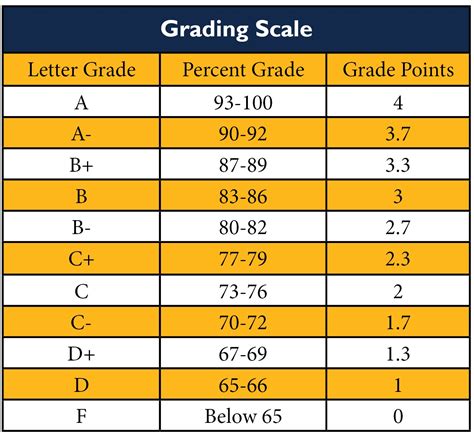Navigating the Maze of Academic Achievement

In the competitive and rigorous landscape of high school, understanding the grading system is essential for students to thrive and reach their academic potential. This comprehensive guide will provide an in-depth analysis of the most common grading scales used in high schools across the United States, empowering students with the knowledge to succeed and achieve their educational goals.
Grading Scales: A National Landscape
According to the National Center for Education Statistics (NCES), the most commonly used grading scales in high schools are:
| Scale Type | Percentage Range | Letter Grade |
|---|---|---|
| 4.0 Scale | 90-100% | A |
| 4.0 Scale | 80-89% | B |
| 4.0 Scale | 70-79% | C |
| 4.0 Scale | 60-69% | D |
| 4.0 Scale | Below 60% | F |
Weighted Grading Scales:
In addition to the traditional 4.0 scale, many high schools also use weighted grading scales that assign additional weight to certain classes, such as honors or Advanced Placement (AP) courses. This means that students who perform well in these classes will receive a higher overall grade point average (GPA).
| Course Type | Weight |
|---|---|
| Regular Class | 1.0 |
| Honors Class | 1.5 |
| AP Class | 2.0 |
Calculating GPA:
The GPA is a numerical representation of a student’s overall academic performance. It is calculated by averaging the quality points earned in each course, multiplied by the weight of the course. The resulting GPA is used by colleges and universities to assess a student’s academic qualifications.
Understanding the 4.0 Scale
The 4.0 scale is the most widely used grading scale in the United States. In this system, letter grades are assigned based on the following percentage ranges:
A: 90-100% B: 80-89% C: 70-79% D: 60-69% F: Below 60%
The A grade represents exceptional academic achievement, while the F grade indicates unsatisfactory performance. The C grade is typically considered the minimum passing grade.
The Impact of Grading Scales on Student Motivation
The grading scale used in high school can have a significant impact on student motivation. Research has shown that students are more likely to be engaged and motivated when they understand the grading system and the criteria for success.
Students need to know:
- What assignments are worth
- How grades are calculated
- What is expected of them to earn a particular grade
By providing students with clear and transparent grading criteria, teachers can create a positive and encouraging learning environment that fosters student success.
Maximizing Academic Performance: Tips for Students
To achieve success in high school, students should consider the following tips:
- Set realistic goals: Establish achievable academic targets and work towards them consistently.
- Engage in active learning: Participate in class discussions, ask questions, and seek support from teachers when needed.
- Attend class regularly: Regular attendance is crucial for understanding the material and developing strong study habits.
- Prioritize assignments: Plan your time effectively and allocate sufficient time to complete assignments thoroughly.
- Seek feedback: Request feedback from teachers on your assignments to identify areas for improvement.
- Utilize study resources: Take advantage of school resources, such as tutoring centers, study groups, and online materials.
- Practice self-assessment: Regularly reflect on your progress and identify areas where you can improve.
Conclusion
Understanding the grading system used in high school is an essential part of academic success. By familiarizing themselves with the different grading scales and criteria, students can develop effective study strategies, set realistic goals, and maximize their performance. Remember, academic achievement is not solely defined by grades, but by the knowledge and skills acquired through the learning process.
